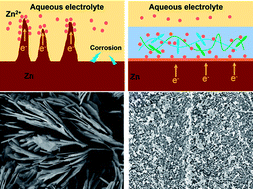Uniformizing the electric field distribution and ion migration during zinc plating/stripping via a binary polymer blend artificial interphase†
Abstract
Aqueous zinc hybrid capacitors are receiving intensive scientific interest due to them having the merits of both capacitors and batteries in achieving safety, high power and energy density, as well as long cycle life. Nonetheless, the dendrite growth and side reactions at the Zn/electrolyte interface are the biggest obstacles preventing them from large-scale applications. Here, we show that a non-conductive polyacrylamide (PAM)/polyvinylpyrrolidone (PVP) binary blend layer coated on a Zn anode can effectively suppress Zn dendrites and side reactions. The precise combination of ultra-high molecular weight PAM and low molecular weight PVP provides an excellent artificial anode/electrolyte interfacial layer with balanced adhesion, mechanical strength and hydrophilicity. The binary polymer interphase fundamentally uniformizes the localized electric field to regulate the ion migration in Zn plating/stripping, giving rise to superior electrochemical performance for the aqueous zinc hybrid capacitors. This study represents a promising approach for mitigating the long-lasting Zn dendrite growth issue.



 Please wait while we load your content...
Please wait while we load your content...